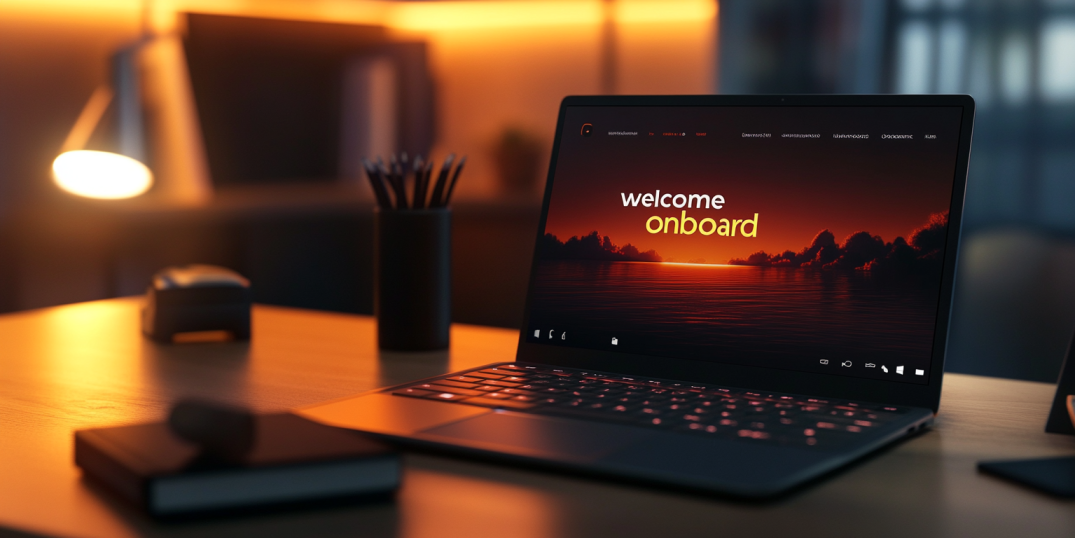- Home
- Email Tips and Tricks
- Onboarding Emails: A Guide for ...

You only get one chance to make a first impression. The saying could not be more true when it comes to onboarding emails in email marketing. During that first encounter, you and your business must be the best versions of themselves.
To begin with, what is an onboarding email?
An onboarding email sets the stage for future interaction with the customer. Having this in mind and not wanting to make a faux pas, you need to view your onboarding email as a strategic message serving to educate, engage, and familiarize your audience with your offering and lay the groundwork for future long-term engagement. Sounds like a rather complicated task. However, nothing ventured, nothing gained.
Single Email vs. Onboarding Sequences
You can send one onboarding email or fire a string of such emails. While a single onboarding email is more of an introductory step, an onboarding email sequence is a string of emails, strategically timed and personalized, aimed at engaging recipients more deeply with your brand over time. A sequence of onboarding emails builds trust and encourages customers to continue using your product or service in the long run.
Key Components of an Effective Onboarding Email Campaign
An effective onboarding campaign’s cornerstones are timing, personalization, and strategic planning. Emails need to be paced and their content tailored to individual customer needs to ensure the likelihood of long-term customer engagement.
The building blocks of an effective onboarding campaign are:
- Welcome email to introduce the brand and set a tone of interacting with the customer.
- Unboxing email gives a short tour of the product or service introduced and highlights the product’s key features.
- Content email offers relevant content that has value beyond merely promoting your product or service.
- Support email offers assistance, creating a sense of support and care with the customer.
- Feedback email sparks a two-way conversation by inviting customers to provide feedback.
- Upselling email strategically introduces additional products or services, taking into account the customer’s prior reaction and preferences gleaned from previous feedback.
How To Write an Effective Onboarding Email
1. A personalized welcome message
Do your best to make that first great impression right from the get-go. We recommend using a warm, personalized message, addressing your prospective customer by name. Also, try to find a way to demonstrate the unique tone and personality of your brand, product, or service. A generic “Welcome to our service” won’t do the job. Instead, think of something more personal like, “Hi [name], we’re thrilled to have you on board!” or something along these lines:
2. A clear call to action (CTA)
The point of writing an onboarding email is to entice the reader to continue the journey, set up an account, continue by exploring the product’s features, or complete a profile. A clear CTA triggers those desired actions. To achieve those goals, a CTA should be both compelling and simple. The best way is to include action-oriented language (“Get Started Now”) and place the CTA button in the body of the email so that it is hard to miss.
3. Value proposition
The benefits of your product or service need to be highly visible in an onboarding email. By highlighting your value proposition, you will make your offering stand out and demonstrate how it answers the customer’s needs. It also serves as a reminder why the user signed up in the first place and shows how your product makes a difference, hopefully a positive change.
4. Educational content
Every day is a school day, so including educational content such as tutorials, guides, or tips helps users make the most of your product. Educational content helps address potential pain points. By including a brief guide on how to use a product’s key feature or a video tutorial, you provide your customer with a shortcut to user satisfaction. After all, the feeling of support boosts consumer confidence and gives your customers peace of mind.
5. Support and contact information
Finally, you must include support and contact information in all onboarding emails, as knowing where to go and where to find answers regarding the product is key to customer satisfaction. It could be in the form of a link to your FAQ page, a support email address, or a live chat. Such information in the onboarding email gives users a safety net they can rely on in their customer experience and greatly boosts their confidence in your product and brand.
Free HTML Onboarding Email Template for SaaS

Why this template works
This onboarding email template reads as cozy as it looks. It sets a warm, inviting tone by welcoming the new user to the community.
It has the perfect structure for a welcome email: starting with a heartfelt greeting, it moves straight to the app features, followed by additional educational resources, and finishes with a support section.
The design and color scheme of this customer onboarding email template deserve special mentioning. The palette, featuring beautiful pastel beige and milk coffee shades, creates the cozy ambiance of a beautiful home. Pictures of stylish interiors further enhance this impression.
Customization ideas
- Personalized room inspiration gallery
Customers engaging with home interior designs often look up for inspiration. Include in your customer onboarding email template a dynamic section that showcases room designs or decor ideas based on the user’s preferences or the type of project they indicated during sign-up (e.g., “Modern Living Room Ideas” or “Cozy Bedroom Concepts”).
- Interactive space planning tool
Add a link or button inviting users to start planning their space. Combine it with a teaser like, “Try our room layout tool to see your space come to life. Add furniture, play with colors, and save your designs!” This interactive option allows users to try your platform and start visualizing their projects right away.
- Virtual style consultant offer
Highlight an option for users to schedule a free session with a virtual style consultant that can generate a personalized design plan. For example, “Not sure where to start? Our virtual style expert will help you create your dream space!” This will give your users additional support while dealing with home décor that can often feel overwhelming.
Free HTML Customer Onboarding Email Template

Why this template works
What stands out with this template is how efficiently the design complements the message. The moment you see this onboarding email template, it leaves no doubt that this one is about SaaS. It’s high-tech, modern-looking design speaks for itself, while the colors and clean lines reflect the sophistication of the software it represents.
But what about the copy? It is very informative and straightforward. It guides users through the app and outlines all its advantages in a very structured way. The inclusion of a quick-start guide and actionable steps ensures users know exactly where to begin. Even small touches, like the integration of a “Resources to help you succeed” section and visually appealing icons for each point, create a comfortable and functional user journey.
This onboarding email template is great at combining form and function, where every element works together to engage, inform, and inspire users to take action.
Customization ideas
- AI-powered personalized setup
Since AI gets more and more integrated in various platforms, including it in a customer onboarding email template might be an expected step to make. Include a button that triggers an AI-driven assistant to guide users through the setup process. For example, it could automatically suggest or implement settings, integrations, and layouts for each particular case.
- Use case spotlight
Showcase a mini-case study or story relevant to the user’s industry or goals. For example, “See how [similar company] used [your SaaS product] to achieve [specific outcome].” With this step, you can provide users with immediate inspiration and confidence in the platform’s value.
- Interactive platform roadmap preview
Include a section that offers users a glimpse into the platform’s future features or updates, with an invitation to provide feedback. For example, “Here’s what’s coming soon: Feature X (ETA next month). Tell us what you’d love to see next!” By engaging users in the development process, you make them feel like co-creators in the exciting process of your app improvement.
Onboarding Email Best Practices
1. Timing and frequency
Timing your onboarding emails properly is a lynchpin to the effectiveness of your onboarding effort. Sending the first email hot on the heels of a recipient’s sign-up or purchase ensures customer engagement. It’s important to strike while the iron is hot! However, you should not overwhelm the customer with the sequence of emails. Make sure you delicately space out further emails—while sending daily might be too frequent, a weekly schedule could help keep engagement strong and steady.
Frequency depends on your product and audience. A sequence spread out over two weeks may work for a SaaS product as you gradually introduce new features. An e-commerce store might benefit from a shorter sequence, highlighting product care tips, upselling opportunities, or loyalty programs. The key is to find the fine balance between being helpful and informative and not overloading the recipient’s inbox.
2. Personalization and segmentation
Personalization is a must in email marketing. By using user data to tailor the content and CTAs, your onboarding emails can significantly boost engagement. Address the recipient by name and mention their specific actions or interests. Let’s say a user signed up for a product demo, then you could include tips on how to make the most of the demo or relevant case studies in your onboarding email.
Segmentation implies that you divide your audience into different groups, such as new sign-ups, trial users, first-time buyers, etc. By doing this, you make your messages more targeted and relevant. For example, users who haven’t completed their profile may be encouraged by an email to finalize the process. Those who have shown interest in a specific product’s features could be guided towards more advanced tutorials or webinars.
3. A/B testing
A/B testing, a.k.a. split testing, helps optimize your onboarding emails. By trying out different subject lines, content formats, CTAs, and the timing of your emails, you discover the best option suitable for a particular situation.
You may experiment with subject lines—one that’s more direct (“Get Started with Your New Account”) and one that’s more engaging but no less subtle (“Ready to Unlock Your Full Potential?”). You may also try out different layouts, sending an email with a lot of text in it, followed by another one with more visuals. Trying out different CTAs, like “Explore Now” versus “Learn More,” can also help find out which variant does a better job generating more click-throughs.
4. Consistency in branding and tone
It is crucial to maintain a consistent brand voice and tone in all onboarding emails so that your brand’s identity is clearly visible, memorable, and consistent. The brand’s identity can be professional, friendly, even playful; the point is not to deviate from it to build trust with your audience.
Brands with strong onboarding identities, such as Dropbox, Slack, Uber, to name just a few, do a great job keeping their tone consistent, whether using fun language or clear instructions. By sticking to the same tone, they ensure that users feel more connected to the brand as they feel that it is all coming from the same place.
Successful Onboarding Email Example
Case study: SaaS company
Following is an example of a simple but efficient onboarding email by a SaaS company.
Subject line: Welcome to Calendly!
Calendly, the popular online meeting scheduling app, have really nailed it with their welcome message. They are sending the user a crystal clear message about what the tool does along with its upside.
The email starts with a strong result-oriented introduction and clearly shows what the tool does: “..puts an end to the scheduling back-and-forth!” It immediately moves on to results: “…save 4 hours a week, or more than 45 minutes a day!”.
Without further ado, they confront the user with: “…you’re ready to start saving that type of time yourself!”
Further down the email, Calendly places a CTA to use any of their ready-to-use links. That is an example of the simpler the better.
10 Effective Onboarding Email Subject Lines
- You’re in! Let’s Unlock the Magic of [Your Platform].
- The Keys to [Your SaaS] Are Yours—Now What?
- Step Inside—Your New Adventure Starts Here!
- Welcome to [Platform Name]—We’ve Saved You a Seat!
- Your [Platform Name] Toolkit Is Ready—Let’s Unpack It Together!
- Think It. Build It. Own It. Your Journey Starts Now.
- We’re Here to Guide You—Let’s Hit the Ground Running.
- Ready to Make Life Easier? Your Tools Are Here.
- You’ve Got the Access—Now Let’s Do Something Amazing!
- It’s Time to Take Charge—Start Creating with [Your Platform].
To Sum Up
To sum up, you need to treat your onboarding email campaign with special care, as it affects the future of your business. As a strategic marketing tool, onboarding emails engage and guide your target audience from the moment of the first contact with the brand.
Deciding whether to go for a single onboarding email or a sequence may be a game-changer. You cannot decide which way to go just by flipping a coin. Though a sequence, as a rule, results in deeper engagement, make sure you do not overwhelm your audience with too many messages!
By carefully following the rules of proper welcoming, timing, personalization, and placing CTAs, you will achieve your onboarding email goals. Just focus on warm and personalized welcomes, include an educational element, and always ensure easy access to support.
At the end of the day, an effective onboarding email is all about making a strong and favorable first impression. Always remember that you only have one chance to do that!



